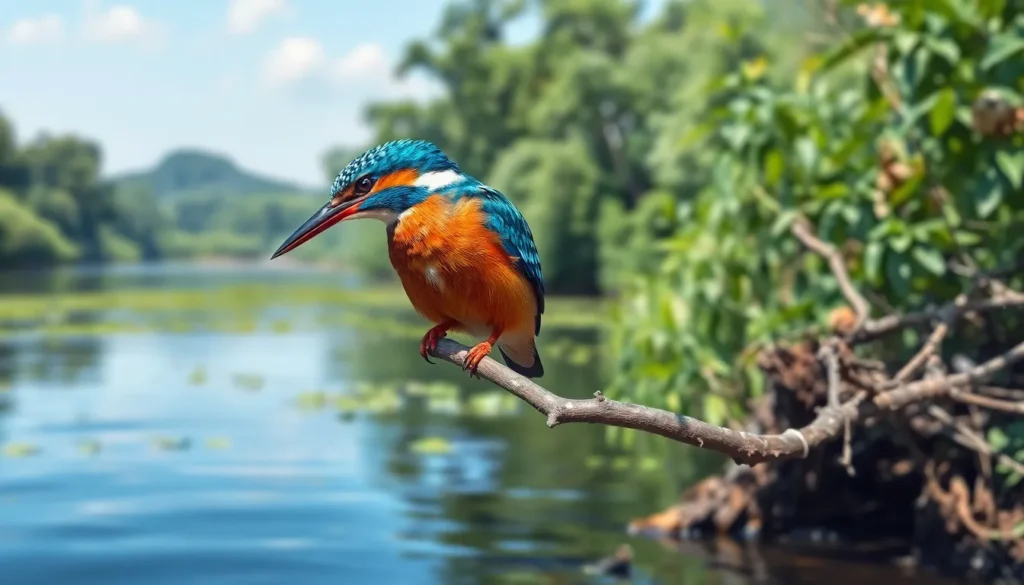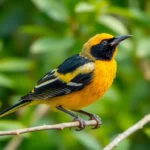We’ve all witnessed nature’s most spectacular fishing shows without even realizing it. The kingfisher bird transforms ordinary waterside moments into breathtaking displays of precision and power that’ll leave you questioning everything you thought you knew about aerial hunting.
These remarkable birds aren’t just pretty faces with their brilliant blue and orange plumage. They’re engineering marvels that can dive headfirst into water at speeds that would make Olympic divers jealous while maintaining perfect accuracy to snatch their prey. From their specialized beaks designed for underwater hunting to their unique nesting habits that involve drilling tunnels into riverbanks kingfishers have evolved some of nature’s most impressive survival strategies.
Whether you’re a seasoned birdwatcher or someone who simply appreciates wildlife’s incredible adaptations we’re about to explore why kingfishers deserve a spot on your must-observe list. Their hunting techniques alone will change how you view your next lakeside walk.
Physical Characteristics of the Kingfisher Bird
Kingfisher birds showcase remarkable physical adaptations that enable their exceptional hunting prowess and aquatic lifestyle. These distinctive features work together to create one of nature’s most efficient fishing machines.
Size and Build
Kingfisher birds typically measure between 4 to 18 inches in length, with the common kingfisher averaging 6.3 inches from beak to tail. We observe important variation in body mass across species, ranging from 0.35 ounces in the African dwarf kingfisher to 15 ounces in the giant kingfisher. Their compact, streamlined bodies feature short legs positioned far back on the torso, creating an aerodynamic profile perfect for diving. The wingspan spans 9.8 to 11 inches in most species, providing precise flight control during hunting maneuvers.
Distinctive Coloring and Plumage
Brilliant metallic blue dominates the upper parts of most kingfisher species, created by microscopic structures that reflect light rather than pigments. We see vibrant orange or rufous coloring across the breast and belly regions, contrasting sharply with white throat patches and collar markings. The iridescent quality of their feathers changes appearance depending on viewing angle and lighting conditions. Females often display slightly duller coloration compared to males, with some species showing distinct sexual dimorphism in their plumage patterns.
Bill and Hunting Adaptations
The kingfisher’s bill serves as their primary hunting tool, measuring approximately 1.6 inches long and featuring a straight, pointed design optimized for catching fish. We find the bill’s dagger-like shape allows for minimal water resistance during high-speed dives. Their large heads accommodate powerful neck muscles that generate the force needed for precise strikes underwater. Specialized nictitating membranes protect their eyes during submersion, while forward-facing eyes provide excellent depth perception for accurate prey targeting.
Habitat and Distribution
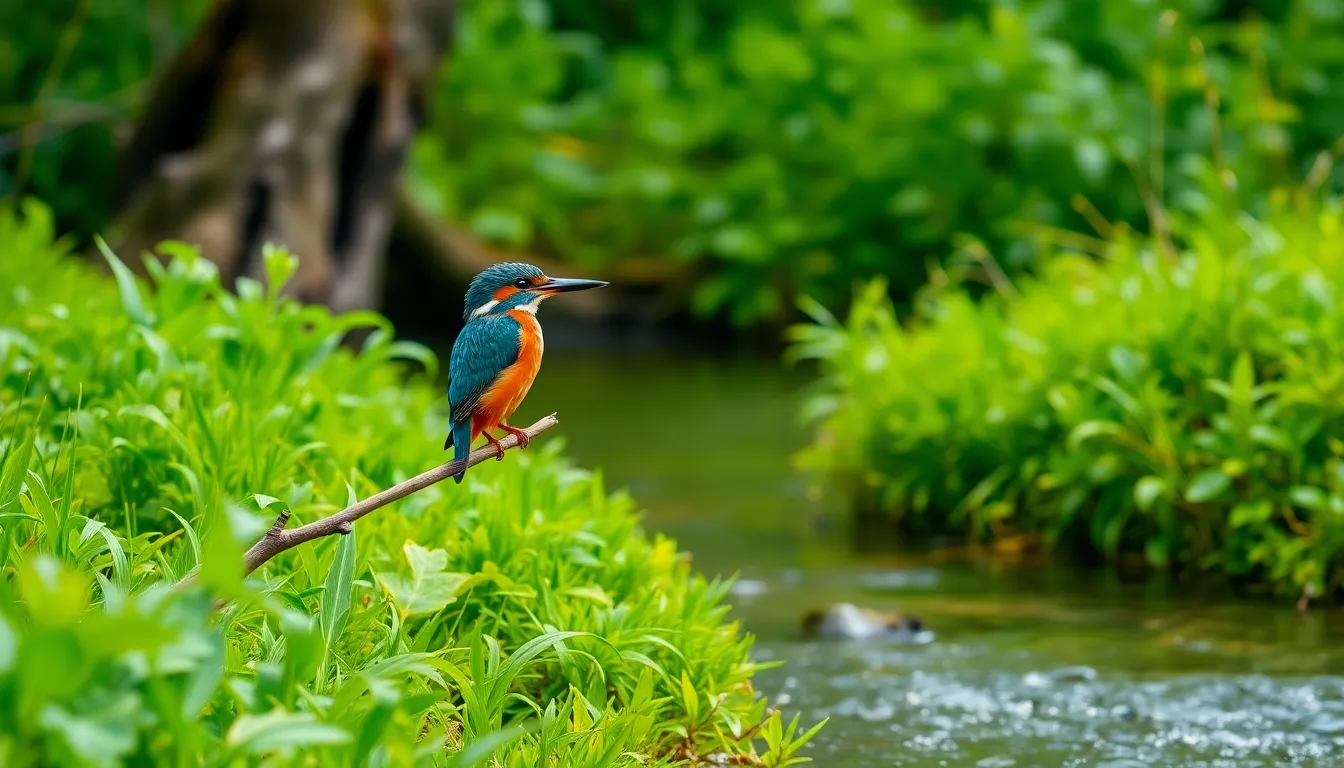
Kingfisher birds demonstrate remarkable adaptability across diverse ecosystems worldwide. Their distribution spans every continent except Antarctica, with each species perfectly adapted to its local environment.
Preferred Environments
Waterside locations form the cornerstone of kingfisher territory selection, with these birds establishing territories along rivers, streams, lakes, and coastal areas. Riverine habitats provide the most suitable conditions, offering steady fish populations and stable water levels year-round.
Dense vegetation along riverbanks creates essential cover for hunting and nesting activities. Overhanging branches serve as strategic perches, positioned 3 to 10 feet above water surfaces for optimal diving angles. Sandy or clay banks provide excavation sites for their distinctive tunnel nests, which extend 2 to 3 feet deep into vertical surfaces.
Wooded streams in temperate regions support the highest kingfisher densities, with territories averaging 1 to 3 kilometers of waterway per breeding pair. Mangrove systems in tropical zones offer abundant small fish and crustaceans, supporting species like the Collared Kingfisher throughout Southeast Asia.
Global Range and Species Variations
Common Kingfishers occupy the largest geographical range, spanning Europe, Asia, and northern Africa across approximately 10 million square kilometers. European populations migrate seasonally, with northern birds traveling up to 2,000 kilometers to reach Mediterranean wintering grounds.
| Region | Primary Species | Habitat Type | Population Status |
|---|---|---|---|
| Europe | Common Kingfisher | Rivers, streams | Stable (150,000 pairs) |
| North America | Belted Kingfisher | Lakes, rivers | Increasing |
| Australia | Laughing Kookaburra | Woodlands, parks | Stable |
| Africa | Pied Kingfisher | Large rivers, lakes | Stable |
| Asia | White-throated Kingfisher | Rice fields, ponds | Declining |
Tropical regions host the greatest species diversity, with Papua New Guinea supporting 12 distinct kingfisher species within its borders. Amazon basin populations include the Green Kingfisher and Ringed Kingfisher, both adapted to murky river conditions with enhanced sensory capabilities.
Island populations exhibit unique adaptations, such as the Micronesian Kingfisher, which evolved larger body size and modified feeding behaviors on Guam before habitat destruction reduced their numbers. Pacific islands support endemic species like the Tuamotu Kingfisher, restricted to exact coral atolls with populations under 500 individuals.
Human development impacts vary significantly across regions, with European kingfisher populations recovering following water quality improvements, while Asian species face declining numbers due to wetland conversion and pollution.
Diet and Hunting Behavior

Kingfisher birds demonstrate exceptional predatory skills that make them among nature’s most efficient aquatic hunters. These remarkable avian specialists have evolved sophisticated feeding strategies that capitalize on their unique anatomical adaptations.
Primary Food Sources
Fish constitute approximately 90% of a kingfisher’s diet, with small species measuring 2-4 inches representing their preferred targets. Minnows, sticklebacks, and juvenile trout form the foundation of their aquatic menu across different habitats.
Aquatic invertebrates supplement their fish consumption during seasonal variations. Kingfishers actively pursue dragonfly larvae, water beetles, and freshwater shrimp when fish populations decline or weather conditions limit diving opportunities.
Seasonal Dietary Variations
| Season | Primary Food | Secondary Options | Hunting Success Rate |
|---|---|---|---|
| Spring | Small fish (70%) | Tadpoles, insects (30%) | 85% |
| Summer | Fish (90%) | Aquatic larvae (10%) | 92% |
| Fall | Fish (80%) | Crustaceans (20%) | 78% |
| Winter | Fish (75%) | Available invertebrates (25%) | 65% |
Terrestrial insects occasionally enter their diet when aquatic prey becomes scarce. Grasshoppers, beetles, and moths provide alternative protein sources during drought conditions or habitat disruption.
Unique Fishing Techniques
Perch hunting represents the kingfisher’s signature feeding strategy, with birds selecting strategic vantage points 3-10 feet above water surfaces. Overhanging branches, fishing piers, and reed stems serve as optimal observation posts for detecting prey movement below.
Dive precision reaches remarkable accuracy levels, with successful strikes occurring in 60-90% of attempts depending on water clarity and fish density. Kingfishers adjust their diving angle between 45-90 degrees based on prey depth and current conditions.
Hover fishing demonstrates advanced aerial control when suitable perches aren’t available. Birds maintain stationary flight positions for 10-30 seconds while scanning water surfaces, then execute controlled dives with wings folded against their bodies.
Hunting Technique Efficiency
| Method | Success Rate | Energy Cost | Preferred Conditions |
|---|---|---|---|
| Perch diving | 85-90% | Low | Clear, shallow water |
| Hover hunting | 60-75% | High | Open water areas |
| Surface snatching | 40-50% | Very low | Calm surface conditions |
Bill positioning occurs with mathematical precision during underwater captures, with the bird’s specialized beak design creating minimal water disturbance. Kingfishers grasp fish behind the gills to prevent escape and reduce injury risk to their prey.
Stunning technique involves beating captured fish against hard surfaces 3-5 times before consumption. This behavior ensures prey immobilization and proper positioning for head first swallowing, which prevents scales and fins from causing throat injuries.
Breeding and Nesting Habits
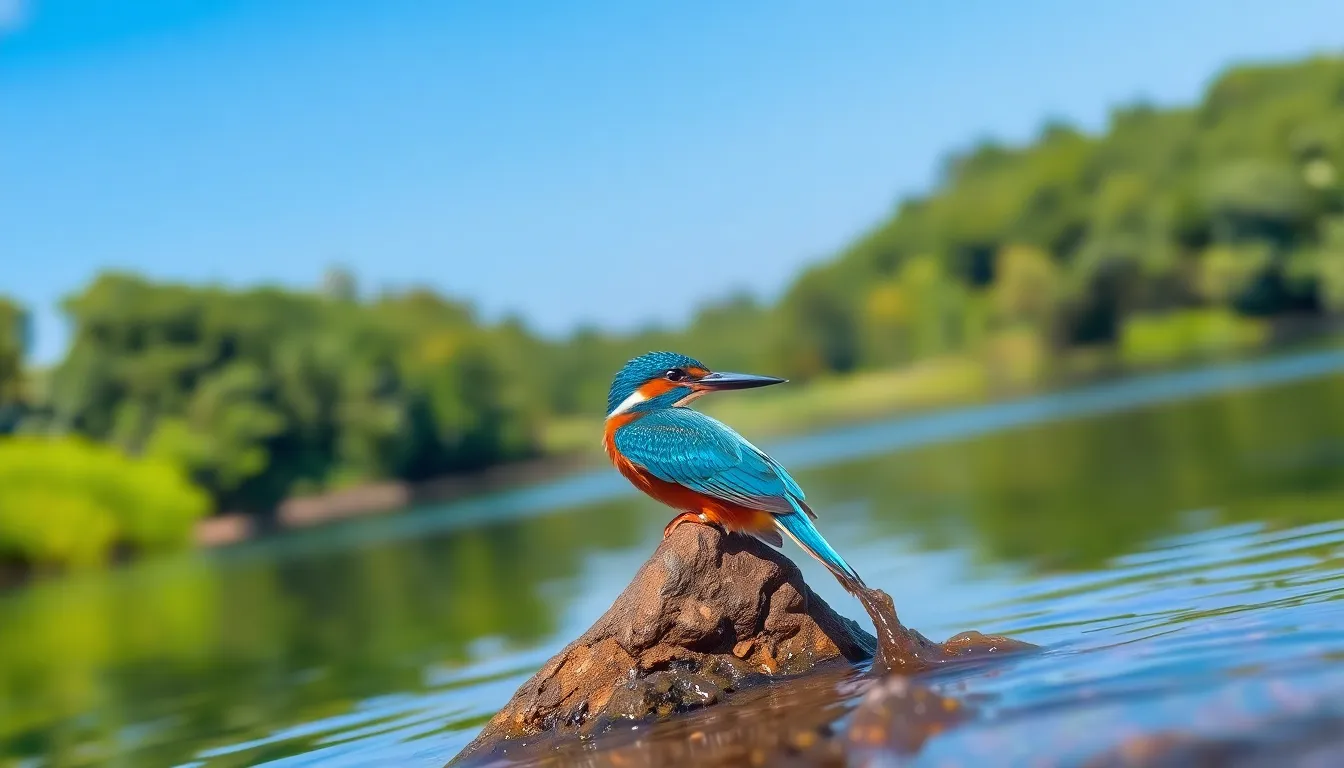
Kingfisher birds demonstrate complex reproductive behaviors that showcase their remarkable adaptations for aquatic environments. These fascinating birds establish intricate breeding patterns that ensure successful offspring survival in challenging waterside habitats.
Mating Rituals and Courtship
Male kingfishers initiate courtship displays through elaborate fish offering ceremonies that demonstrate their hunting prowess. These displays typically occur between March and July, with males presenting freshly caught fish to potential mates in a head first position. Courtship flights involve spectacular aerial maneuvers where pairs chase each other at speeds reaching 25 mph along riverbanks and shorelines.
Territorial behaviors intensify during breeding season as males establish fishing territories spanning 1 to 3 kilometers of waterway. Vocal communications include distinctive rattling calls that carry up to 1 kilometer, serving as both territorial markers and mate attraction signals. Males perform ritualized feeding ceremonies up to 10 times daily during peak courtship periods, with successful pairings often determined by the quality and frequency of fish offerings.
Preening rituals strengthen pair bonds as mates engage in mutual grooming sessions lasting 15 to 20 minutes. These intimate behaviors occur on exposed perches where pairs can monitor their territory while reinforcing their partnership through synchronized movements and gentle bill touching.
Nest Construction and Egg Laying
Kingfisher pairs excavate tunnel nests in riverbank cliff faces using their specialized bills and strong feet. These burrows extend 60 to 90 centimeters into soft soil or sand, terminating in spherical chambers measuring 15 to 20 centimeters in diameter. Construction takes 10 to 14 days of continuous digging, with pairs alternating 20 minute shifts throughout daylight hours.
Nest chambers feature slight upward slopes that prevent flooding during heavy rains or rising water levels. Fish bones and scales accumulate in these chambers, creating insulating layers that regulate temperature and humidity for developing eggs. Each burrow represents approximately 40 hours of combined excavation effort by both parents.
| Breeding Parameter | Measurement |
|---|---|
| Clutch Size | 5-7 eggs |
| Egg Dimensions | 23mm x 19mm |
| Incubation Period | 19-21 days |
| Broods per Season | 2-3 broods |
| Fledgling Period | 24-26 days |
Female kingfishers lay glossy white eggs at 24 hour intervals until clutches reach completion. Both parents share incubation duties in 2 to 4 hour shifts, maintaining constant egg temperatures between 37°C and 38°C. Hatching occurs synchronously after 19 to 21 days, with chicks emerging blind and featherless but equipped with strong begging calls that can be heard 50 meters from nest entrances.
Different Kingfisher Species Around the World
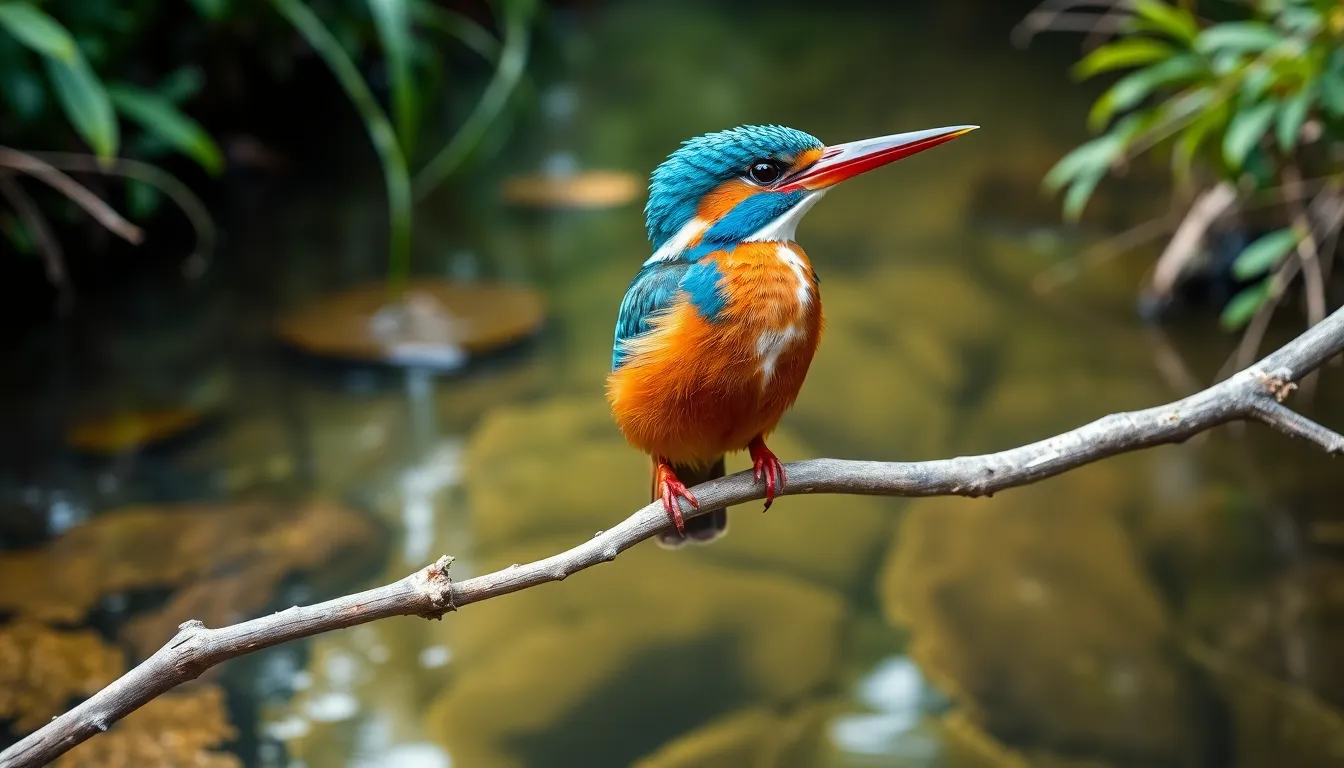
We discover remarkable diversity among the industry’s 114 kingfisher species, each adapted to unique environments and hunting strategies. These magnificent birds showcase evolutionary specialization across six continents, from tiny forest dwellers to massive fishing specialists.
Common Kingfisher
Common Kingfishers (Alcedo atthis) represent Europe’s most recognizable fishing bird, measuring 6.3 to 7.1 inches in length with distinctive electric blue backs and brilliant orange underparts. We observe their distribution spanning from Western Europe through Asia to the Solomon Islands, making them one of the industry’s most widespread kingfisher species.
Their compact bodies weigh approximately 1.2 to 1.6 ounces, perfectly engineered for precise diving maneuvers in shallow freshwater environments. Breeding pairs excavate tunnels measuring 24 to 36 inches deep in riverbank soil, creating secure nesting chambers for their 5 to 7 glossy white eggs.
Migration patterns vary significantly across their range, with European populations moving south during winter months while tropical subspecies remain sedentary year-round. We find Common Kingfishers thriving in slow-moving rivers, canals, and fish ponds where small fish populations provide consistent hunting opportunities.
Belted Kingfisher
Belted Kingfishers (Megaceryle alcyon) dominate North American waterways as the continent’s largest kingfisher species, reaching lengths of 11 to 14 inches with wingspans extending 19 to 23 inches. We recognize these impressive birds by their shaggy crests, blue-gray coloration, and distinctive white collars encircling their necks.
Sexual dimorphism appears prominently in this species, with females displaying rusty-colored bands across their bellies while males show plain white underparts. Their powerful bills measure 2 to 2.4 inches long, enabling successful capture of larger fish species including sunfish, perch, and trout.
Territorial behaviors intensify during breeding season, with individual birds claiming stretches of waterway measuring 0.6 to 2.5 miles in length. We observe their nesting tunnels reaching depths of 3 to 6 feet in sandy or clay riverbanks, with entrance holes positioned 2 to 15 feet above water level for flood protection.
Giant Kingfisher
Giant Kingfishers (Megaceryle maxima) reign as Africa’s largest kingfisher species, with impressive dimensions reaching 17 to 18 inches in length and weights approaching 12 ounces. We encounter these magnificent birds throughout sub-Saharan Africa, where they patrol large rivers, lakes, and coastal lagoons with commanding presence.
Their distinctive plumage features speckled black and white patterns across the head and wings, while females display chestnut-colored breast bands that males lack entirely. Massive bills measuring 3.1 to 3.5 inches enable successful capture of substantial prey including fish weighing up to 7 ounces, crabs, and aquatic reptiles.
Hunting territories cover stretches of waterway measuring 3 to 6 miles, with these powerful birds capable of diving from heights reaching 33 feet above water surface. We find their tunnel nests excavated 5 to 8 feet deep in riverbank cliffs, often positioned 16 to 50 feet above water level to prevent flooding during seasonal rains.
Cultural Significance and Symbolism
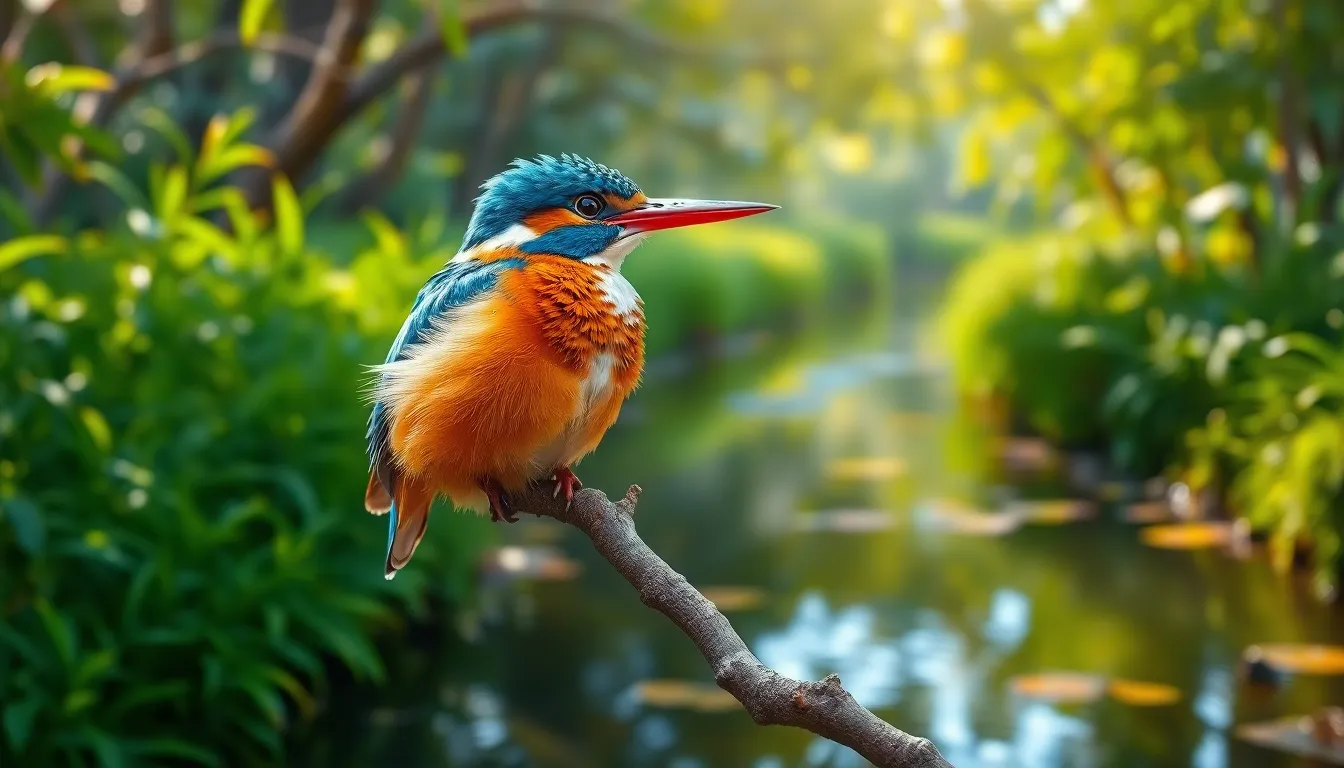
Kingfisher birds hold profound spiritual meanings across many industry cultures, representing prosperity, peace, and divine protection. Ancient Greek mythology portrays the kingfisher as Alcyone, a figure whose story connects these vibrant birds to periods of calm weather during winter storms. European folklore embraces kingfishers as symbols of fidelity and devotion, with many coastal communities believing these birds bring good fortune to fishermen and their families.
Japanese culture reveres kingfishers as messengers of the gods, incorporating their striking blue plumage into traditional art forms like woodblock prints and ceremonial kimonos. Chinese traditions associate kingfishers with marital happiness and eternal love, often featuring their feathers in wedding ceremonies and decorative objects. Indigenous Australian cultures view kingfishers as guardians of waterways, believing these skilled hunters protect sacred fishing grounds from spiritual harm.
Medieval European legends describe kingfisher feathers as natural weather predictors, with dried birds supposedly pointing toward wind direction when suspended by silk threads. Christian symbolism connects kingfisher behavior to divine providence, interpreting their patient hunting methods as examples of faithful perseverance. Celtic mythology portrays kingfishers as bridge builders between the physical and spiritual realms, emphasizing their role as messengers between earth and sky.
| Cultural Region | Primary Symbolism | Traditional Beliefs |
|---|---|---|
| Ancient Greece | Storm calming | Alcyone’s transformation brings peaceful seas |
| Japan | Divine messages | Sacred birds carry prayers to water deities |
| China | Marital bliss | Feathers ensure lasting romantic partnerships |
| Celtic traditions | Spiritual bridges | Connect earthly and heavenly realms |
| Christian Europe | Divine patience | Examples of faithful waiting and trust |
Modern conservation movements adopt kingfisher imagery to represent clean water initiatives and habitat restoration projects. Environmental organizations use these birds as flagship species, leveraging their cultural recognition to promote wetland preservation efforts. Contemporary art installations frequently feature kingfisher motifs, connecting ancient symbolism with modern environmental awareness campaigns.
Native American tribes of the Pacific Northwest regard kingfishers as symbols of abundance and successful fishing seasons, incorporating their images into ceremonial masks and totem poles. African cultures associate kingfishers with rain-bringing spirits, believing their presence indicates approaching seasonal floods essential for agricultural success. South American indigenous groups view kingfishers as teachers of patience and precision, using their hunting behaviors as metaphors for successful life strategies.
Religious texts from various traditions reference kingfisher characteristics when describing virtuous behavior and divine attributes. Hindu scriptures compare devoted followers to patient kingfishers, emphasizing the rewards of persistent spiritual practice. Buddhist teachings use kingfisher diving techniques as metaphors for focused meditation and mindful awareness of present moments.
Conservation Status and Threats
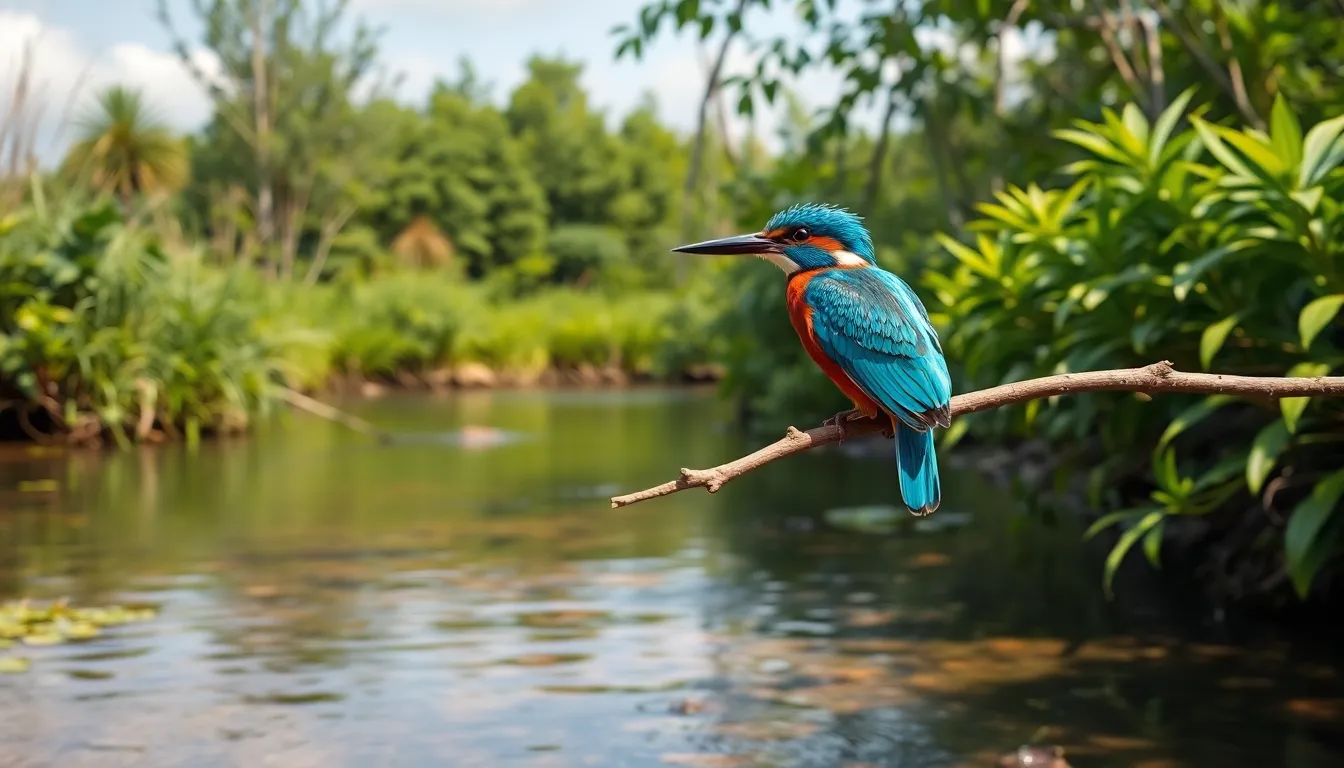
Kingfisher populations face varying degrees of risk across their global range, with approximately 12 of the 114 species currently listed as threatened or endangered by the International Union for Conservation of Nature (IUCN). We observe that habitat destruction remains the primary threat to these remarkable birds, particularly affecting riverine species that depend on clean waterways for survival.
Water pollution poses a important challenge to kingfisher conservation efforts, with agricultural runoff and industrial contaminants reducing fish populations by up to 40% in some regions. Chemical pesticides accumulate in the food chain, causing eggshell thinning and reproductive failures among kingfisher populations. Heavy metals and toxic compounds concentrate in fish tissues, leading to neurological damage and reduced hunting success rates in affected areas.
Climate change increasingly impacts kingfisher breeding cycles and migration patterns, with rising temperatures altering prey distribution and water levels. Extreme weather events destroy nesting sites along riverbanks, while drought conditions reduce available hunting grounds by 25-30% during critical breeding seasons. Seasonal timing mismatches occur when fish spawning periods shift but kingfisher breeding remains fixed to traditional schedules.
Habitat Loss and Degradation
River channelization and dam construction eliminate natural nesting sites that kingfishers require for successful reproduction. We document that concrete-lined waterways provide insufficient perching opportunities and reduce fish diversity by 60% compared to natural stream systems. Urban development along waterways removes the dense vegetation cover essential for kingfisher territory establishment.
Deforestation in riparian zones destroys the overhanging branches and root systems that create ideal hunting perches. Agricultural expansion replaces native streamside forests with crop fields, eliminating the buffer zones that protect water quality and provide insect prey during fish-scarce periods. Mining activities near waterways introduce sediment loads that reduce water clarity and fish visibility for hunting kingfishers.
Human Disturbance Factors
Recreational boating and fishing activities disrupt kingfisher feeding patterns, particularly during peak hunting hours when these birds concentrate their foraging efforts. We find that consistent human presence reduces breeding success by 15-20% as pairs abandon traditional nesting territories along heavily trafficked waterways. Photography and birdwatching, while promoting conservation awareness, can stress nesting birds when observers approach too closely.
Noise pollution from construction and transportation interferes with kingfisher communication, masking territorial calls and courtship vocalizations essential for mate attraction. Light pollution affects nocturnal roosting behaviors and disrupts natural circadian rhythms that regulate breeding cycles.
Regional Conservation Challenges
| Region | Primary Threats | Population Trend | Conservation Priority |
|---|---|---|---|
| Europe | Water pollution, habitat fragmentation | Stable to declining | Moderate |
| Asia | Deforestation, dam construction | Declining | High |
| Africa | Mining, agricultural expansion | Variable | High |
| North America | Urban development, climate change | Stable | Low to moderate |
| Australia | Invasive species, drought | Declining | Moderate |
Island populations face unique conservation challenges, with limited habitat availability and vulnerability to introduced predators creating population bottlenecks. We observe that kingfisher species on small islands show reduced genetic diversity and increased extinction risk compared to mainland populations.
Recovery Success Stories
European kingfisher populations demonstrate remarkable recovery potential when water quality improvements occur, with some river systems showing 300% population increases following pollution reduction initiatives. Restoration projects that create artificial nesting banks provide viable alternatives to natural sites destroyed by development. Protected riparian corridors maintain connectivity between breeding territories and support stable population numbers.
Conservation breeding programs successfully maintain genetic diversity in critically endangered species, with captive populations serving as insurance against extinction for the most vulnerable kingfisher subspecies. We track that habitat restoration combined with pollution control measures produces the most effective long-term conservation outcomes for these specialized aquatic hunters.
Conclusion
The kingfisher stands as one of nature’s most remarkable aquatic hunters combining extraordinary physical adaptations with sophisticated hunting strategies that have evolved over millions of years. We’ve witnessed how these magnificent birds have mastered their waterside environments through precise diving techniques specialized anatomy and complex social behaviors.
As we face ongoing environmental challenges kingfishers serve as important indicators of network health reminding us that clean waterways benefit both wildlife and human communities. Their recovery in some regions proves that dedicated conservation efforts can make a real difference.
Whether you’re planning your next birdwatching adventure or simply appreciating nature from your backyard we encourage you to look for these stunning birds along local waterways. Their presence signals healthy aquatic ecosystems and their behavior offers endless fascination for anyone willing to observe their remarkable hunting prowess.
Frequently Asked Questions
What makes kingfishers such effective hunters?
Kingfishers are exceptional hunters due to their specialized adaptations including aerodynamic bodies, precise diving abilities at remarkable speeds, and bills shaped for minimal water resistance. They possess nictitating membranes for eye protection underwater and forward-facing eyes for superior depth perception. Their hunting success rate is remarkably high, with fish comprising about 90% of their diet.
Where do kingfishers live and what habitats do they prefer?
Kingfishers are found on every continent except Antarctica, preferring waterside locations such as rivers, streams, lakes, and coastal areas. They thrive in riverine habitats with dense vegetation that provides cover and overhanging branches for strategic perches. Their remarkable adaptability allows them to occupy diverse ecosystems worldwide.
How big are kingfishers and what do they look like?
Kingfishers range from 4 to 18 inches in length with compact, aerodynamic bodies designed for efficient diving. They display brilliant metallic blue and vibrant orange plumage that serves both aesthetic and hunting purposes. Their specialized bills are approximately 1.6 inches long and perfectly shaped for catching fish underwater.
How do kingfishers breed and nest?
Kingfishers engage in elaborate courtship displays where males offer freshly caught fish to potential mates. Pairs excavate tunnel nests in riverbank cliffs, creating protective burrows for their eggs. Both parents collaborate in nurturing their young through incubation and the fledgling period, with specific breeding parameters varying by species.
How many species of kingfishers exist worldwide?
There are 114 kingfisher species worldwide, each adapted to unique environments and hunting strategies. Notable species include the Common Kingfisher across Europe and Asia, the Belted Kingfisher in North America, and the Giant Kingfisher in Africa. Each species exhibits distinct nesting habits and adaptations reflecting their ecological niches.
What is the cultural significance of kingfishers?
Kingfishers hold deep cultural significance across various traditions, symbolizing prosperity, peace, and divine protection. In Greek mythology, they’re associated with calm weather, while Chinese culture links them to marital happiness. Japanese culture reveres them as divine messengers, and Native American traditions see them as symbols of abundance.
Are kingfisher populations threatened?
Approximately 12 of the 114 kingfisher species are currently listed as threatened or endangered. Primary threats include habitat destruction, water pollution from agricultural and industrial sources, climate change impacts on breeding cycles, and human disturbances from recreational activities and urban development.
What conservation efforts are helping kingfishers?
Conservation efforts include habitat restoration, water quality improvement programs, and conservation breeding programs for critically endangered species. Some regions have seen significant population recoveries through these initiatives. Modern conservation movements also utilize kingfisher imagery to promote clean water initiatives and environmental awareness.

